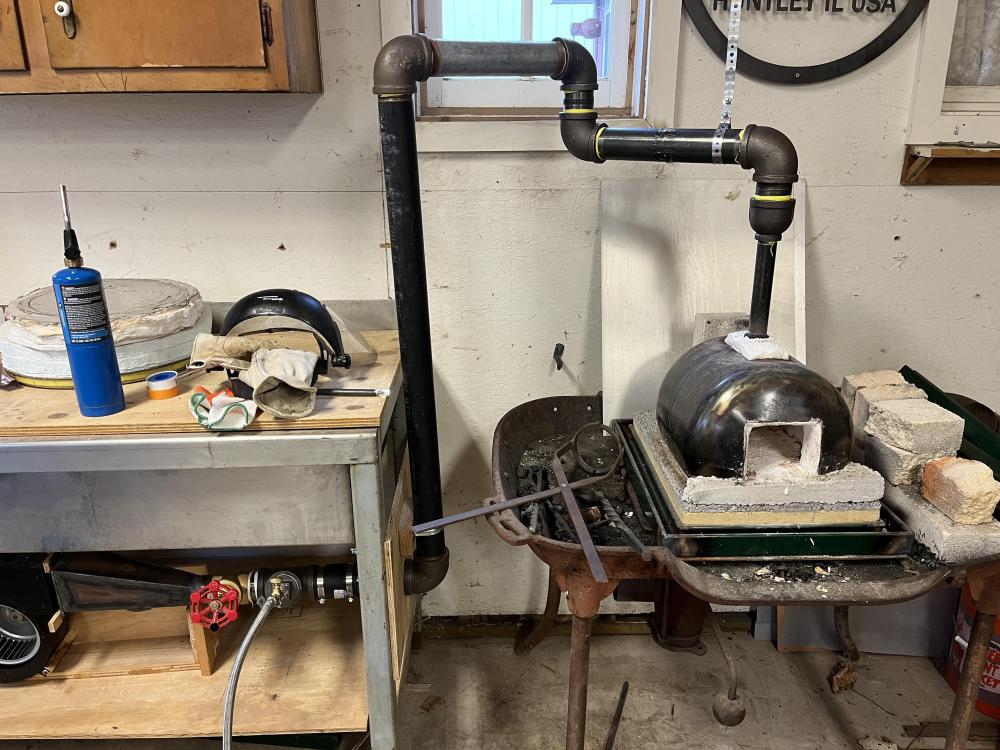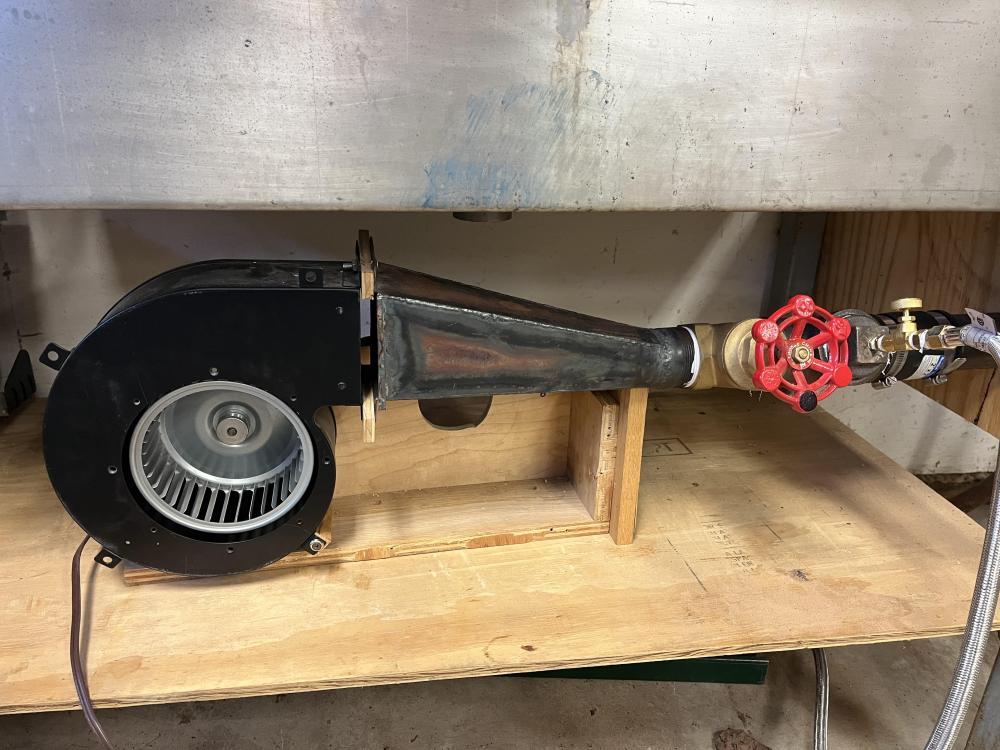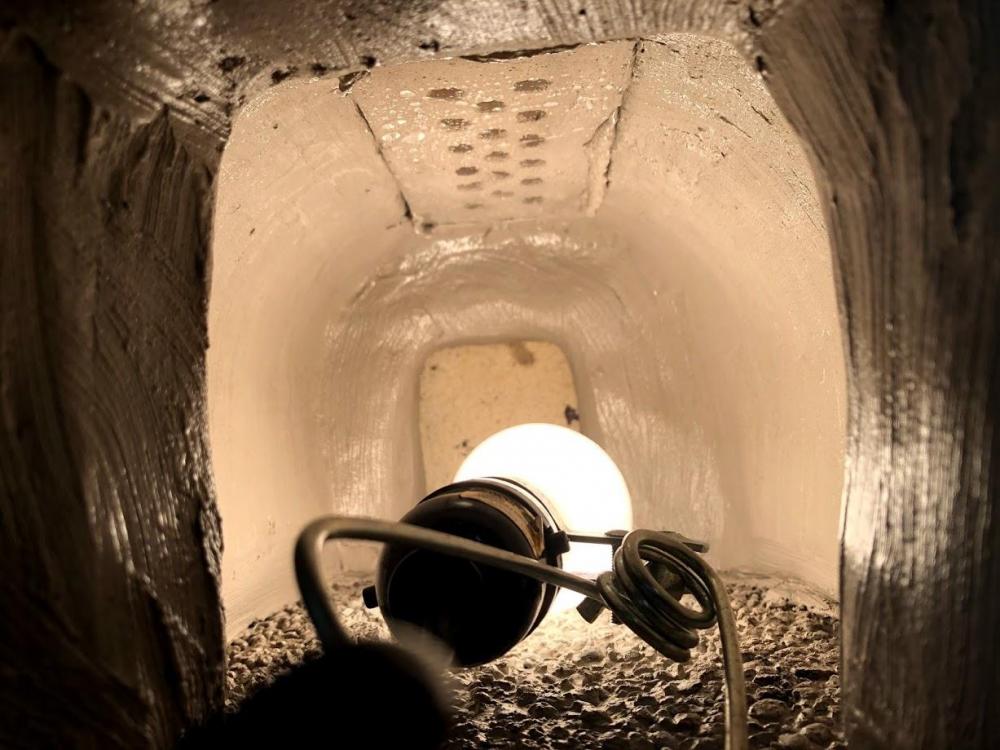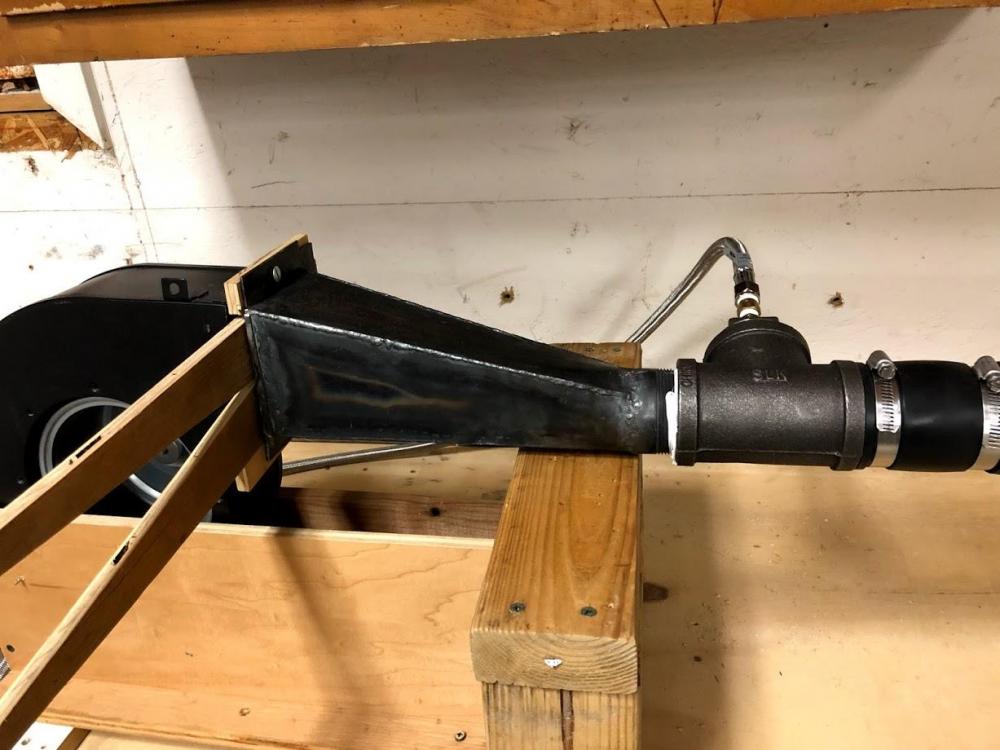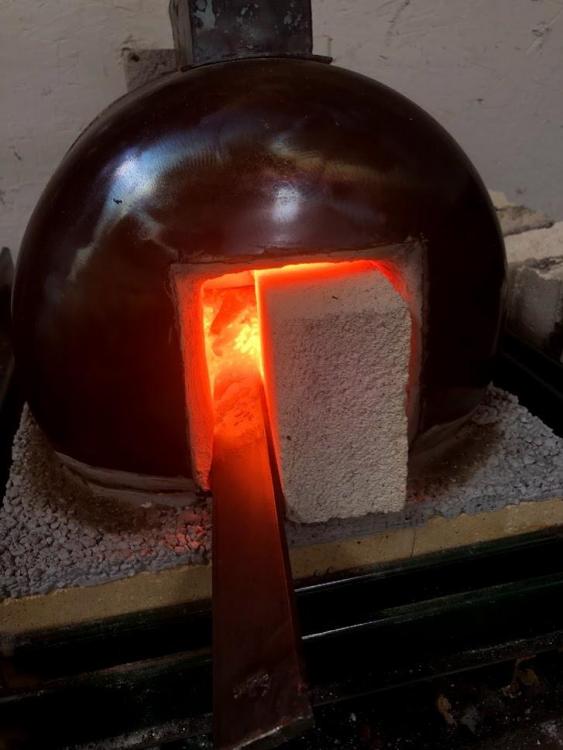
Selkirk
Members-
Posts
18 -
Joined
-
Last visited
Profile Information
-
Location
Huntley, IL
Recent Profile Visitors
The recent visitors block is disabled and is not being shown to other users.
-
My wallet needs a break for a bit but this forge is just a straight pipe burn. My ribbon burner block started cracking so I swapped it out for a straight pipe. The change was why I was asking for help troubleshooting the burner. My ribbon burner never worked amazingly anyway, so I didn’t feel it a big loss. I definitely need a redo on my forge. Like you said, it works, but it can be better. I think I’ll end up with 2 forges. One larger oval shaped forge with a wide but short opening for my large pieces and a small NA forge for my smaller projects. Probably a brick pile. I loved the design I saw in frosty’s post earlier with the beginner forge. That would be perfect for small hooks and nails and the like. It was a great exercise though. I learned a lot! Selkirk
-
Ok, just got to test it last night. I increased the pipe diameter to 1.5 and hand shaped a slight flare in the ceramic blanket with rigidizer. It Definitely seems more stable at startup. Once hot, I had no issue closing off the front door a bit. Thanks all! Selkirk
-
I’ve got the 1.5” pipe installed but the flare from 1.5” to 2” at the end of the burner is not fitting. Rather than cutting at the forge to fit it, I am considering shaping the flare out of the ceramic blanked I need to pack around it. is this a safe strategy? For a forced air burner does the shape of the flare matter? Bell? Cone? Straight step? Thanks! Selkirk
-
Awesome. Thanks for everyone’s input. I think I’ll I’ve got a lot of small tweaks here I’ve picked up here that I believe will help considerably. I actually have a “baffle” on the back of the forge for my rear exit for larger stock. Just an insulating brick with some Matrikote painted on its face. I need a more elegant solution in the front but I’m glad to know that I’m on the right track. The flame velocity/ keeping the flame in the forge longer is resonating as well. I think this makes increasing that pipe diameter a top priority. I’ll post an update once I’m able to get it updated. Hopefully with some great results to show!
-
Thank you for all the valuable feedback gentlemen. Latticino - I am not introducing any secondary air. It's all strictly through the blower. Although I've read quite a bit in these forums about blower pressure vs CFM I have to admit I'm still not clear on the details. I used this blower simply because it was free. I regulate air with a gate valve and have never been able to fully open it. When I start the forge I open less than 10%. I've always taken this as a sign that I have adequate pressure since I seem to get enough air. Please let me know if I'm missing something with that conclusion. I'll have to observe more carefully the conditions in which the flame goes out after partly closing the opening as I don't recall a color change. Mikey - I was able to create the yellowish flame when I increased the gas with my needle valve. This was shortly after startup. I definitely saw that yellow color right after I coated my wool with Matrikote! I was quite alarmed but it went away after I had run it for a short period of time. Frosty - I did a search for door baffles but I'm not sure what you are referring to. Any elaboration would be appreciated. My forge is not that hot or fuel efficient so any tips here are appreciated. Flatliner - At startup it definitely seems that air speed is too fast to keep the flame. It was my understanding that a big diameter reduction like this was intentional and somewhat of a safety mechanism to prevent the flame from propagating up the tube? How much difference in diameter is really needed? A few of you mentioned reducing the number of 90-degree bends. I was making due with the materials I on-hand. It's difficult for me to get the cuts I need and have them threaded. Also, I was counting on the angles helping with the mixing. If I am getting adequate air flow does this really matter? The first time I fired the forge I had kept the air low even after it had warmed up because I kept losing the flame. I was assuming it was excess airflow. I noticed that my flare and even a bit of the burner pipe started getting cherry red and turned off the forge. I think this could be a sign of combustion in the tube? On my next fire I increased air and fuel as the forge warmed and did not see this occur. Is it possible that the flame going out when I block the forge opening is because I have to turn down the air so much at startup that my flame is going out due to lack of oxygen? And on my first startup this also resulted in combustion inside the flare? If this is the case then perhaps if I block the port after the forge has warmed up I might not have any issue? Thanks again for your insights! Selkirk
-
Hi all, I recently had time to get back to my forge. My ribbon burner was cracking and was always touchy so I went to a straight pipe with a flare. I am seeing some odd behavior I would like to understand and am hoping the forums expert eyes can help. this is when forge is first lit. I would like to close off the front opening more but when I do, the flame dies. https://photos.app.goo.gl/4dw4SYqCp2GYnkqJ6 this is when I start to turn up the gas and air. Not sure what is happening here… lots of yellow flame but all burning in secondary flame?? https://photos.app.goo.gl/yRVrkohjmPKuTkbe7 The next two are taken as forge warms up and air and gas are slowly increased. https://photos.app.goo.gl/LcfZzboWH2xjtTWA7 https://photos.app.goo.gl/2famm9GPUncGaCFp9 am I too gas rich at startup? Why can’t I use a firebrick to partly close off entrance without flame going out? At what point is it safe to start increasing propane injection to increase heat and minimize oxidation of steel? thanks all.
-
Thank you for your responses gentlemen. You insight is appreciated. It sounds like I have several different options to test. I’ll be sure to follow frosty’s advice and change only one thing at a time! I am sadly going to be away from my shop a bit. But when I get results I’ll be sure to share for those who may be interested.
-
I've got nothing against the science here. And I grasp the concept of the evaporation of the liquid as it maintains pressure. Even if it has been a minute since high school chem! Early on I definitely experienced some freezing. But ever since I put my tank in water I have not lost pressure as the forge ran. If I am not losing pressure then doesn't that mean the evaporation is keeping up with consumption? And therefore I am maintaining the number of BTU's I am expecting? This was my understanding of this mechanism. And when I have run this way it still takes a while to reach yellow heat. Therefore a larger gas tank(while certainly convenient!) would not on it's own solve this, correct? Not to say I'm against larger tank volumes. I was already considering that before dropping my single tank in water. But I feel like maybe the two problems got tangled up in this thread?
-
Thanks for all the responses gents. I would like to ask a follow up question about the tank size because I am having a hard time wrapping my head around this. Unless I misunderstood, the suggestion is a larger propane volume will improve fuel supply to get the forge hotter? I was under the impression that if my little 20# tank was putting out a given PSI then my energy output was also steady regardless of whether or not the tank was freezing or not? There also seems to be a huge range in forge fuel requirements to operate at yellow heat. And I suppose that reflects the wide variety of forges and uses. In terms of my forge doors they were simply not given any thought. I was completely preoccupied with the ribbon burner and insulation and didn’t consider how important a role they actually play. My first forge was coal so it wasn’t even something I had to worry about. When I run I have the back completely covered with IFB. Not a perfect seal but 90% blocked. I wedge a chunk of brick in the front to block 2/3 of the opening. Maybe still just not closed off enough? if I had to do it again I would make a lower square end to the forge and just use bricks to seal off the ends. I do mostly decorative stuff so bends and scrolls all need to fit. The flexibility of the adjustable opening would be nice!
-
That actually brings up a related question I had. The first five or 6 times I used the forge I definitely saw dropping pressure and had to continually open the regulator to maintain pressure. I had heard about tanks icing and could feel the frost on the outside of my tank. So I did some reading on the thread in this forum and decided to try something a little novel. I got a tub of water and threw the tank in along with a coil of roof de-icing wire. It's meant to melt snow off areas where it builds up too much. I think it's may be 300-500 watts of warming. After about 2 hours of run time that water was like 98F. Like a nice warm bath. And amazingly as my forge warmed up I had to continually dial down the pressure in order to prevent excess 'dragon's breath' from coming out the front of my forge. But I can't understand what effect I'm seeing there. I didn't change my air output so why would a warmer tank running at the same pressure result in more dragon's breath? Unless my gauge also changed performance as my garage warmed up or something? The last two times I've used a tub of cool water without the warming coil and it has actually been even more stable. It really is quite surprising how effective just plain ol' water is! The bottom line is that the water did help a bit so your hunch was totally legitimate however even with that yellow heat is still not easy for me. Perhaps I'm being unrealistic with the amount of gas required to heat and maintain that large a chamber to yellow heat? How many BTU's do other folks need to use to operate at yellow heat? Thanks again for your consideration Binesman.
-
It definitely steamed on the first fire, but not since. I tried to post a video but it doesn’t seem to be working. I will have to look into that. 20 lb propane tank. My personal theory is that I have a whole list of minor issues. Poor insulation, slightly too large chamber and doors that don’t seal well. It’s forced air and propane, so I feel pretty good about getting those BTUs into the forge but my amateur guess is too many of those BTUs are just heating my garage. that is why I am thinking about another inch of insulating castable on the floor and the Matrikote. But I’m definitely worried about what is going to happen with those two different layers. Does this theory sound off base? Thanks Binesman.
-
I'd be happy to elaborate. I can get orange within about 15 minutes. But then for full yellow it takes a while and I really have to crank the gas. I've cranked it up to 10psi after 2 hours and couldn't get any more than a yellow on some quarter-round. It's a Forced air ribbon burner. I've got a large squirrel cage blower with a home made wooden damper to tune. I'll probably upgrade to a gate valve soon because it's touchy. For Gas it's a high pressure regulator which I run through an .035" MIG tip. I have 30+ inches and one 90-degree bend before the ribbon burner. I run 2" pipe all the way to the burner. I've attached pictures of the blower/gas injection as well as a photo of the inside of the forge after I covered the wool with Satanite. The video was taken at about 20-30 minutes of start-up and was probably about 3-5psi. The clearly visible blue flame goes away after about 30+ minutes as the chamber gets hot. Another comment on insulation... I've got two 1" layers of wool behind the satanite but I was paranoid and really went to town with rigidizer on each layer. Is it possible to compromise thermal conductivity severely but over-rigidizing? The outside of my forge gets *very* hot. Thanks! IMG_1963.MOV
-
Good Morning All, I built my first forge over the winter but after running a few times I'm seeing a number of problems with how I built it. I'm hoping that now that I understand the operation and my needs better I can tweak it rather than start over. The first problem I need to overcome is forge temperature. I have a hard time reaching yellow heat. It takes at least an hour to warm up enough to be able to reach that temp. From my reading here it sounds like my choice of hard fire bricks on the bottom is a big mistake. Currently I have a 1/2" top coat of 3000F castable to protect the brick. I'm thinking of adding a 1" thick layer of 2800F castable that I already have. It's a little better insulating (0.45W/mk) and will reduce the total volume of my forge. This would bring it down from 575cuIn to about 500cuIn. I just received some Matrikote for my final layer as well. Any thoughts on whether or not this is likely to be worth the time and effort? On whether or not a fresh layer of castable will bond to an existing lightly used surface without falling apart? Thanks in advance for your thoughts!
-
Thank you for the feedback thomas. Glad to hear it’s going to be useful. I have a small electric foundry with PID controller and a thermocouple. I feel pretty good about my odds of getting those tempering numbers dead on. Does annealing prior to forging provide any benefit? i took a few whacks at the steel a bit ago and it was incredibly tough at orange heat. I read somewhere that orange heat is where tool steels should be forged so their molecular structure remains intact and you don’t lose their properties. Does this sound right? You mention near welding temperatures above. Thanks!
-
On a whim I bought a remnant of 5/8square A-11 at a steel supplier. I was intending on using it to make some punches and chisels. I also need a new spring fuller. I want to make a nail header at some point too. But as I read through this section of the forum I can see that there are some huge differences between these high carbon steels. Any thoughts on what might be appropriate for this stuff?
